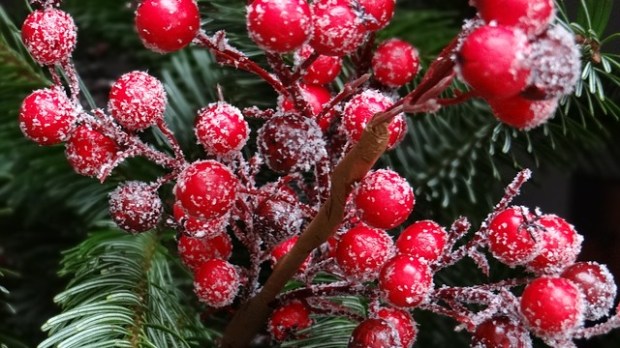I stumbled on this today, in a longer piece by Charlotte Allen in The Wall Street Journal:
That supposedly unadorned Starbucks cup still has a religious connotation: Red is a Christmas color because it is the shade of the holly berry, associated with Christmas and its theological meaning since at least the 15th century. As one carol has it: “The holly bears a berry, / As red as any blood, / And Mary bore sweet Jesus Christ / For to do us sinners good.” Order a latte at Starbucks, and you will be honoring, even in attenuated fashion, the infant who was brought into this world to shed his blood for human redemption.
That sent me scrambling to find more about the background and history of the famous colors of Christmas. And that turned up this intirguing nugget, from Cambridge:
“We associate Christmas with red and green because that’s the way we’ve always done it.” said Dr [Spike] Bucklow. “But one can trace the roots of this colour coding back through the centuries, to a time when the colours themselves had symbolic meaning, possibly as a way of accentuating a significant division or a boundary.” Although the Victorians wholeheartedly embraced Christmas and introduced many of the traditions we see today – from cards to crackers and trees to turkeys – Dr Bucklow believes that the Christmas colours were not inspired by the Victorians but rather revived by them, and that their significance draws on a history many centuries older. His research over the past three years, funded by the Leverhulme Trust, has focused on the art history of medieval rood screens, which date from the 14th to the 16th centuries and were used to separate the nave from the chancel of churches. “Although many were defaced or even destroyed during the Reformation, on some of those that survive are beautiful painted panels depicting saints, as well as local donors, merchants and serfs. They were commissioned by parishioners and represent the biggest investment of corporate art that this country has ever seen,” he said. Strikingly, the vast majority are painted in red and green. “The panels were painted by newly settled members of the Flemish immigrant population or by itinerant English and continental European artists who worked together,” he explained. “Choosing red and green would have been a question of pigment availability but it would also have represented a tradition based on a consciously chosen symbolic meaning. If you like, these colours would have been part of a common language of panel painting that everyone knew about but didn’t necessarily express.” Dr Bucklow speculates that this meaning is linked to an emphasising of the different spaces in the Church: at one side of the screen, the nave where the parishioners sat; at the other side, the priest’s holy sanctuary and the altar. He further suggests that the Victorians, who carried out some of the early restoration of the medieval churches, would have noticed the colour coding and might have adopted it to accentuate another boundary – the end of one year and the beginning of another at Christmas.
And then there’s this:
Evergreen plants, like Holly, Ivy and Mistletoe have been used for thousands of years to decorate and brighten up buildings during the long dark winter. They also reminded people that spring would come and that winter wouldn’t last forever! The Romans would exchange evergreen branches during January as a sign of good luck. The ancient Egyptians used to bring palm branches into their houses during the mid winter festivals. In many parts of Europe during the middle ages, Paradise plays were performed, often on Christmas Eve. They told Bible stories to people who couldn’t read. The ‘Paradise Tree’ in the garden of eden in the play was normally a pine tree with red apples tied to it. Now the most common use of green at Christmas are Christmas Trees. As mentioned above, an early use of red at Christmas were the apples on the paradise tree. They represented the fall of Adam in the plays. Red is also the color of Holly berries, which is said to represent the blood of Jesus when he died on the cross. Red is also the color of Bishops robes. These would have been worn by St. Nicholas and then also became Santa’s uniform!
Taken all together, perhaps Starbucks is more pious than we thought…or than their corporate gurus realize.
Photo: Pixabay

